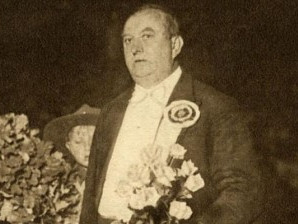
Emilis Melngailis
(15.02.1874 - 20.12.1954 )
A composer, active in community affairs and forthright journalism, whose prominent position in Latvian music emanates from his focus on folk music and folklore in his research and creative work. His interest in the use of the folk song in the music of Russian composers induced him to forgo his studies in Dresden in 1897 in favour of the St. Petersburg Conservatory, from which he graduated in 1901 as an external student. As an ethnomusicologist Melngailis collected some 5,000 folk melodies; of these 4,500 Latvian folk melodies were published.
The characteristics of folk music – the use of the diatonic scales and other modes, antiphonal singing and polyphonic texture, as well as the principles of variation in development – became the stylistic norm and a model for his work. This applied not only to his arrangements of folk music and his substantial works based on folklore (some 250 for choir, and over 200 for various ensembles), but frequently to his own compositions. His works for choir, during this period up to 1918, were not great in number, but are among the best in Latvian music. Melngailis also composed a ballet, orchestral music, a string quartet, solo songs, and music for piano.
E. Melngailis has earned a special place in Latvian culture for his tenacity and achievement in successfully introducing the principles of traditional folk music into works composed by professional musicians. It is from ethnic music that the character of his choral music has developed: it shows consistent use of diatonic harmonies, bourdon techniques, antiphonal singing and polyphonic texture, variation form, and an overall emotional restraint presented with baroque opulence. Melngailis studied composition at the St. Petersburg Conservatory. When he graduated in 1901, he had already made his debut as composer, journalist, folklorist and choir conductor. He worked abroad until 1920. On his return to Latvia he continued his work in folklore, and was also Principal Conductor and organizer of all the Latvian National Song Festivals of his time. During numerous concert performances with a choir of his own founding, Melngailis gained approval for his own style of choral music, as displayed both in his own compositions (about 100) and in his arrangements of folk music (some 250 altogether). His works were issued progressively in a ten-part series, In Groves and Glades (Birzēs i norās, 1–10, 1902–1957).
Keenly supporting the restoration of Mussorgsky's original score of Boris Godunov, Melngailis effected its performance at the Latvian National Opera in May 1924 – the world premiere of this opera without Rimsky-Korsakov's revisions. In the years following the Second World War Melngailis collated the folklore material he had gathered throughout his life – some 4,500 items – and it was published in Latvian Dance (Latviešu dancis, Riga, 1949) and Latvian Folk Music Material (Latviešu mūzikas folkloras materiāli, 1–3, Riga, 1951–1953).
His most active years, both as folklore collector and composer, proved to be the 1920s and 1930s, after his return to Latvia. During this period Melngailis published volumes four to eight of his ten-volume series of choral arrangements and original compositions Birzēs i norās [In Groves and Glades] in which his choral style is fully manifested. Melngailis' style, more than that of any of his predecessors, respected the specific features of the most ancient forms of Latvian folk music – the use of natural diatonic scales, polyphonic and antiphonal textures, modality and bourdon techniques. The values represented by the content and form of ancient Latvian folklore were no longer just elements of adornment but gradually became basic compositional principles, and hence Melngailis opened up a new era in the relationship between Latvian composers and folklore. His success was largely a result of his familiarity with his material: during his lifetime Melngailis collected over 4,500 items of folklore material, notated from almost 1,000 singers. He compiled the greater part of this material and published it as Latviešu mūzikas folkloras materiāli [Latvian Folk Music Material](1–3, 1951–1953).
